Inhibition Mechanism of EMIM-Cl to Methane Gas Hydrate by Molecular Dynamics Simulation
Abstract
1. Introduction
2. Molecular Model and Simulation Method
3. Results and Discussion
3.1. Methane Hydrate Formation under Inhibition Effect of EMIM-Cl
3.2. System Energy Variations
3.3. AOP Variations of Water Molecular
3.4. Inhibition Mechanism of EMIM-Cl to Hydrate Cage Structure
3.4.1. Destruction of Cages by Hydrogen Bonding
3.4.2. Steric Hindrance Effects of EMIM-Cl
3.4.3. Evolution of Hydrate Incomplete Cage with EMIM-Cl
4. Conclusions
- (1)
- By molecular dynamics simulation to calculate the average generation rate in the presence of hydrate inhibitor system, the results show that gas hydrates in the pure water system average growth rate of 4.49 Å /ns, and in systems containing inhibitors gas hydrate growth rate of 6.92 Å /ns, after joining this inhibitor can obviously reduce the hydrate crystal cell growth rate.
- (2)
- Compared with a pure water system, the growth of hydrate in a EMIM-Cl-containing system was delayed by about 10 ns by the analysis of total energy of the growth system, methane hydrate growth area, which confirmed that the EMIM-Cl-containing system exhibited a significant inhibition effect on hydrate growth and could be used as a type of potential hydrate inhibitor for offshore oil and gas development.
- (3)
- According to the molecular simulation results, it was believed that the inhibition mechanism of EMIM-Cl on hydrates was due to the combined effect of hydrogen bonds and steric hindrance, in which hydrogen bond could cause local disorder of cage structure formed by water molecules, and steric hindrance could lead to an incomplete cage structure.
- (4)
- In a EMIM-Cl-containing system, some six-membered rings of SI methane hydrate cage-like structure evolved from five-membered rings, and the whole evolution process lasted about 4.1 ns, which delayed the formation time of overall methane hydrate to a certain extent.
Author Contributions
Funding
Data Availability Statement
Conflicts of Interest
Abbreviations
| Acronyms | Full Name |
| AOP | Angular order parameters |
| LDHIs | low dosage inhibitors |
| LAMMPS | Large-scale Atomic/Molecular Massively Parallel Simulator |
| MD | Molecular dynamics simulation |
| THI | Thermodynamic hydrate inhibitor |
| KHI | Kinetic hydrate inhibitor |
| ILs | Ionic liquids |
References
- Yang, H.J.; Wu, M.W.; Yang, J.H.; Liang, H.; Jiang, H.F. Operation mode and key technologies for ultra-deep water gas well testing: A case study of first ultra-deep water gas well LSE1 in the South China Sea. China Offshore Oil Gas 2016, 28, 38–43. [Google Scholar] [CrossRef]
- Joao, V.A.; Raphael, M.; Sascha, T. Hydrate Remediation During Well Testing Operations in the Deepwater Campos Basin, Brazil. In Proceedings of the SPE/ICoTA Coiled Tubing & Well Intervention Conference & Exhibition, The Woodlands, TX, USA, 26–27 March 2013; SPE163881. pp. 154–196. [Google Scholar] [CrossRef]
- Yang, S.K.; Dai, Y.D.; Lv, Y. Key techniques of gas well testing in South China Sea deep water. China Offshore Oil Gas 2009, 21, 237–241. [Google Scholar] [CrossRef]
- Koh, C.A. Towards a fundamental understanding of natural gas hydrates. Chem. Soc. Rev. 2002, 31, 157–167. [Google Scholar] [CrossRef] [PubMed]
- Fan, S.S.; Wang, Y.H.; Lang, X.M. Progress in the research of kinetic hydrate inhibitors. Nat. Gas Ind. 2011, 31, 99–109. [Google Scholar] [CrossRef]
- Eslamimanesh, A.; Mohammadi, A.H.; Richon, D.; Naidoo, P.; Ramjugernath, D. Application of gas hydrate formation in separation processes: A review of experimental studies. J. Chem. Thermodyn. 2012, 46, 62–71. [Google Scholar] [CrossRef]
- Kelland, M.A. History of the Development of Low Dosage Hydrate Inhibitors. Energy Fuels 2006, 20, 825–847. [Google Scholar] [CrossRef]
- Xiao, C.; Wibisono, N.; Adidharma, H. Dialkylimidazolium halide ionic liquids as dual function inhibitors for methane hydrate. Chem. Eng. Sci. 2010, 65, 3080–3087. [Google Scholar] [CrossRef]
- Bavoh, C.B.; Nashed, O.; Rehman, A.N.; Othaman, N.A.A.B.; Lal, B.; Sabil, K.M. Ionic Liquids as Gas Hydrate Thermodynamic Inhibitors. Ind. Eng. Chem. Res. 2021, 60, 15835–15873. [Google Scholar] [CrossRef]
- Ul Haq, I.; Qasim, A.; Lal, B.; Zaini, D.B.; Foo, K.S.; Mubashir, M.; Khoo, K.S.; Vo, D.-V.N.; Leroy, E.; Show, P.L. Ionic liquids for the inhibition of gas hydrates. A review. Environ. Chem. Lett. 2022, 20, 2165–2188. [Google Scholar] [CrossRef]
- Masri, A.N.; Sulaimon, A.A. Amino acid-based ionic liquids as dual kinetic-thermodynamic methane hydrate inhibitor. J. Mol. Liq. 2022, 349, 118481. [Google Scholar] [CrossRef]
- Menezes, D.É.S.d.; Pessôa Filho, P.d.A.; Robustillo Fuentes, M.D. Use of 1-butyl-3-methylimidazolium-based ionic liquids as methane hydrate inhibitors at high pressure conditions. Chem. Eng. Sci. 2020, 212, 115323. [Google Scholar] [CrossRef]
- Yuha, Y.B.M.; Bavoh, C.B.; Lal, B.; Broni-Bediako, E. Methane hydrate phase behaviour in EMIM-Cl water based mud (WBM): An experimental and modelling study. S. Afr. J. Chem. Eng. 2020, 34, 47–56. [Google Scholar] [CrossRef]
- Zare, M.; Haghtalab, A.; Ahmadi, A.N.; Nazari, K. Experiment and thermodynamic modeling of methane hydrate equilibria in the presence of aqueous imidazolium-based ionic liquid solutions using electrolyte cubic square well equation of state. Fluid Phase Equilibria 2013, 341, 61–69. [Google Scholar] [CrossRef]
- Khan, M.S.; Bavoh, C.B.; Partoon, B.; Lal, B.; Bustam, M.A.; Shariff, A.M. Thermodynamic effect of ammonium based ionic liquids on CO2 hydrates phase boundary. J. Mol. Liq. 2017, 238, 533–539. [Google Scholar] [CrossRef]
- Richard, A.R.; Adidharma, H. The performance of ionic liquids and their mixtures in inhibiting methane hydrate formation. Chem. Eng. Sci. 2013, 87, 270–276. [Google Scholar] [CrossRef]
- Tung, Y.-T.; Chen, L.-J.; Chen, Y.-P.; Lin, S.-T. Growth of Structure I Carbon Dioxide Hydrate from Molecular Dynamics Simulations. J. Phys. Chem. C 2011, 115, 7504–7515. [Google Scholar] [CrossRef]
- Plimpton, S. Fast Parallel Algorithms for Short-Range Molecular Dynamics. J. Comput. Phys. 1994, 117, 1039. [Google Scholar] [CrossRef]
- McMullan, R.K.; Jeffrey, G.A. Polyhedral Clathrate Hydrates. IX. Structure of Ethylene Oxide Hydrate. J. Chem. Phys. 1965, 42, 2725–2732. [Google Scholar] [CrossRef]
- Jorgensen, W.L.; Maxwell, D.S.; Tirado-Rives, J. Development and Testing of the OPLS All-Atom Force Field on Conformational Energetics and Properties of Organic Liquids. J. Am. Chem. Soc. 1996, 118, 11225–11236. [Google Scholar] [CrossRef]
- Waldron, C.J.; English, N.J. Global-density fluctuations in methane clathrate hydrates in externally applied electromagnetic fields. J. Chem. Phys. 2017, 147, 024506. [Google Scholar] [CrossRef]
- Boda, D.; Henderson, D. The effects of deviations from Lorentz–Berthelot rules on the properties of a simple mixture. Mol. Phys. 2008, 106, 2367–2370. [Google Scholar] [CrossRef]
- Mohrdieck, C. Physical Chemistry for the Life Sciences. By Peter Atkins and Julio de Paula. ChemPhysChem 2006, 7, 1149. [Google Scholar] [CrossRef]
- Jorgensen, W.L.; Chandrasekhar, J.; Madura, J.D.; Impey, R.W.; Klein, M.L. Comparison of simple potential functions for simulating liquid water. J. Chem. Phys. 1983, 79, 926–935. [Google Scholar] [CrossRef]
- Faúndez, C.A.; Mulero, A.; Cuadros, F. Molecular models for the vapor-liquid equilibrium of simple binary mixtures. J. Phase Equilibria 2001, 22, 531–538. [Google Scholar] [CrossRef]
- Anderson, B.J.; Tester, J.W.; Borghi, G.P.; Trout, B.L. Properties of inhibitors of methane hydrate formation via molecular dynamics simulations. J. Am. Chem. Soc. 2005, 127, 17852–17862. [Google Scholar] [CrossRef]
- Udachin, K.A.; Ratcliffe, C.I.; Ripmeester, J.A. Single crystal diffraction studies of structure I, II and H hydrates: Structure, cage occupancy and composition. J. Supramol. Chem. 2002, 2, 405–408. [Google Scholar] [CrossRef]
- Bernal, J.D.; Fowler, R.H. A Theory of Water and Ionic Solution, with Particular Reference to Hydrogen and Hydroxyl Ions. J. Chem. Phys. 1933, 1, 515–548. [Google Scholar] [CrossRef]
- Ryckaert, J.P.; Herman, J.C.; Berendsen, H. Numerical integration of the cartesian equations of motion of a system with constraints: Molecular dynamics of n-alkanes. J. Comput. Phys. 1977, 23, 327–341. [Google Scholar] [CrossRef]
- Darden, T.; York, D.; Pedersen, L. Particle mesh Ewald: AnN⋅log(N) method for Ewald sums in large systems. J. Chem. Phys. 1993, 98, 10089–10092. [Google Scholar] [CrossRef]
- Verlet, L. Computer “Experiments” on Classical Fluids. I. Thermodynamical Properties of Lennard-Jones Molecules. Phys. Rev. 1967, 159, 98–103. [Google Scholar] [CrossRef]
- Verlet, L. Computer Experiments on Classical Fluids. II. Equilibrium Correlation Functions. Phys. Rev. 1968, 165, 201–214. [Google Scholar] [CrossRef]
- English, N.J.; MacElroy, J.M. Theoretical studies of the kinetics of methane hydrate crystallization in external electromagnetic fields. J. Chem. Phys. 2004, 120, 10247–10256. [Google Scholar] [CrossRef]
- Frenkel, D.; Smit, B.; Ratner, M.A. Understanding Molecular Simulation: From Algorithms to Applications. Phys. Today 1997, 50, 66. [Google Scholar] [CrossRef]
- Pollock, E.L.; Glosli, J. Comments on P3M, FMM, and the Ewald Method for Large Periodic Coulombic Systems. Comput. Phys. Commun. 1996, 95, 93–110. [Google Scholar] [CrossRef]
- Yu, K.B.; Yazaydin, A.O. Does Confinement Enable Methane Hydrate Growth at Low Pressures? Insights from Molecular Dynamics Simulations. J. Phys. Chem. C Nanomater. Interfaces 2020, 124, 11015–11022. [Google Scholar] [CrossRef]
- Ghaani, M.R.; English, N.J. Molecular-dynamics study of propane-hydrate dissociation: Fluctuation-dissipation and non-equilibrium analysis. J. Chem. Phys. 2018, 148, 114504. [Google Scholar] [CrossRef]
- Shirts, R.B.; Burt, S.R.; Johnson, A.M. Periodic boundary condition induced breakdown of the equipartition principle and other kinetic effects of finite sample size in classical hard-sphere molecular dynamics simulation. J. Chem. Phys. 2006, 125, 164102. [Google Scholar] [CrossRef]
- Walsh, M.R.; Beckham, G.T.; Koh, C.A.; Sloan, E.D.; Wu, D.T.; Sum, A.K. Methane Hydrate Nucleation Rates from Molecular Dynamics Simulations: Effects of Aqueous Methane Concentration, Interfacial Curvature, and System Size. J. Phys. Chem. C 2011, 115, 21241–21248. [Google Scholar] [CrossRef]
- Wan, L.; Liang, D.; Wu, N.; Guan, J. Molecular dynamics simulations of the mechanisms of thermal conduction in methane hydrates. Sci. China Chem. 2012, 55, 167–174. [Google Scholar] [CrossRef]
- Bai, J.; Li, D.L.; Liang, D.Q.; Fan, S.S.; Du, J.W.; Dai, X.X. Thermal analysis on the process of CO2 hydrate formation in static HiGee reactor. Nat. Gas Chem. Ind. 2010, 35, 30–34. [Google Scholar] [CrossRef]
- Li, K.; Chen, B.; Song, Y.; Yang, M. Molecular dynamics simulation of the effects of different thermodynamic parameters on methane hydrate dissociation: An analysis of temperature, pressure and gas concentrations. Fluid Phase Equilibria 2020, 516, 112606. [Google Scholar] [CrossRef]
- Gao, F.; Gupta, K.M.; Yuan, S.; Jiang, J. Decomposition of CH4 hydrate: Effects of temperature and salt from molecular simulations. Mol. Simul. 2018, 44, 1220–1228. [Google Scholar] [CrossRef]
- Kondori, J.; Zendehboudi, S.; James, L. New insights into methane hydrate dissociation: Utilization of molecular dynamics strategy. Fuel 2019, 249, 264–276. [Google Scholar] [CrossRef]
- Binsbergen, F.L. Computer simulation of nucleation and crystal growth. J. Cryst. Growth 1972, 16, 249–258. [Google Scholar] [CrossRef]
- Jiménez-Ángeles, F.; Firoozabadi, A. Nucleation of Methane Hydrates at Moderate Subcooling by Molecular Dynamics Simulations. J. Phys. Chem. C 2014, 118, 11310–11318. [Google Scholar] [CrossRef]
- Zi, M.; Chen, D.; Wu, G. Molecular dynamics simulation of methane hydrate formation on metal surface with oil. Chem. Eng. Sci. 2018, 191, 253–261. [Google Scholar] [CrossRef]
- Luzar, A.; Chandler, D. Hydrogen-bond kinetics in liquid water. Nature 1996, 379, 55–57. [Google Scholar] [CrossRef]
- Zhang, L.; Sun, L.; Lu, Y.; Kuang, Y.; Ling, Z.; Yang, L.; Dong, H.; Yang, S.; Zhao, J.; Song, Y. Molecular dynamics simulation and in-situ MRI observation of organic exclusion during CO2 hydrate growth. Chem. Phys. Lett. 2021, 764, 138287. [Google Scholar] [CrossRef]
- Yousuf, M.; Qadri, S.B.; Knies, D.L.; Grabowski, K.S.; Coffin, R.B.; Pohlman, J.W. Novel results on structural investigations of natural minerals of clathrate hydrates. Appl. Phys. A 2004, 78, 925–939. [Google Scholar] [CrossRef]
- Vatamanu, J.; Kusalik, P.G. Molecular Insights into the Heterogeneous Crystal Growth of sI Methane Hydrate. J. Phys. Chem. B 2006, 110, 15896–15904. [Google Scholar] [CrossRef]

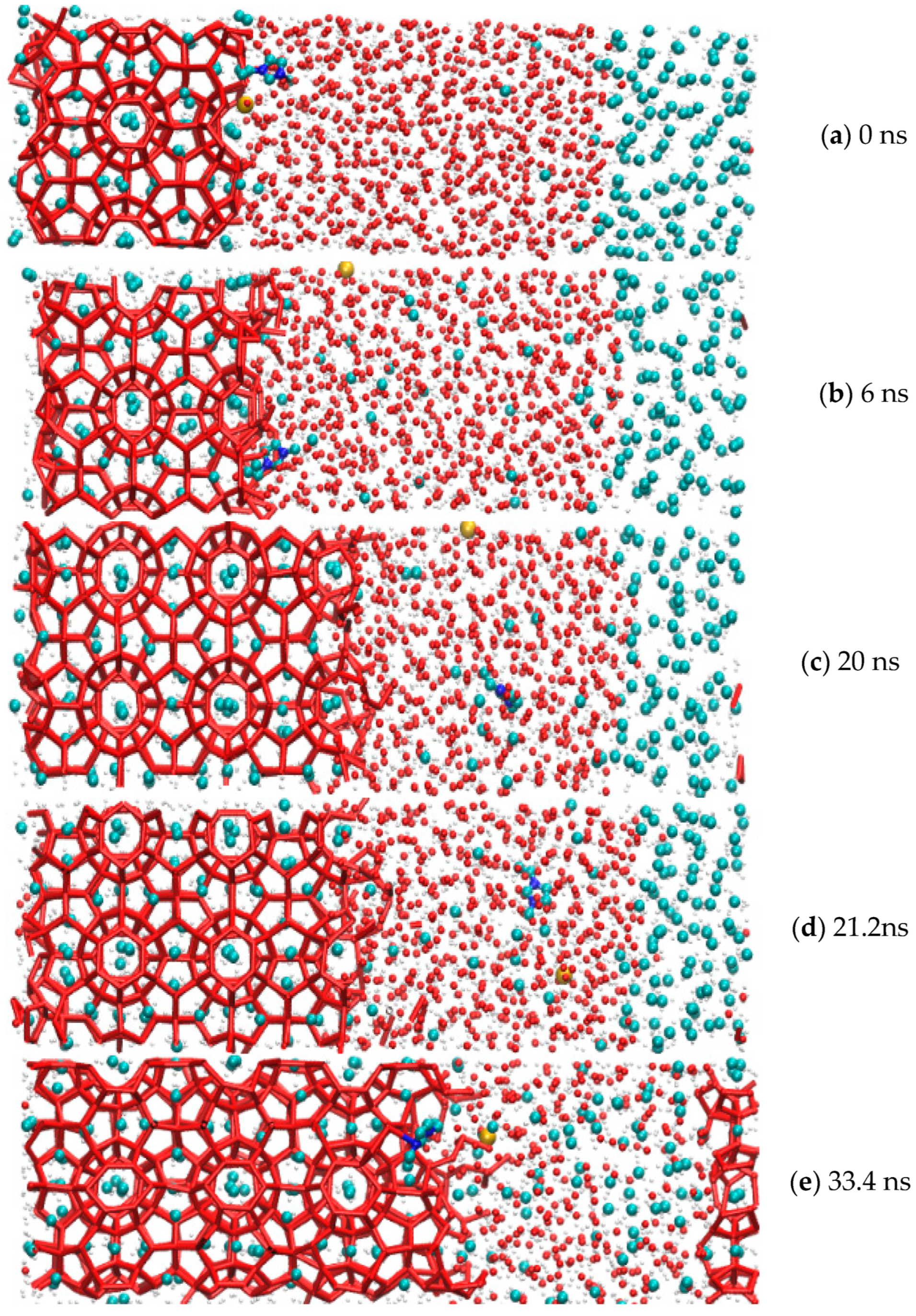


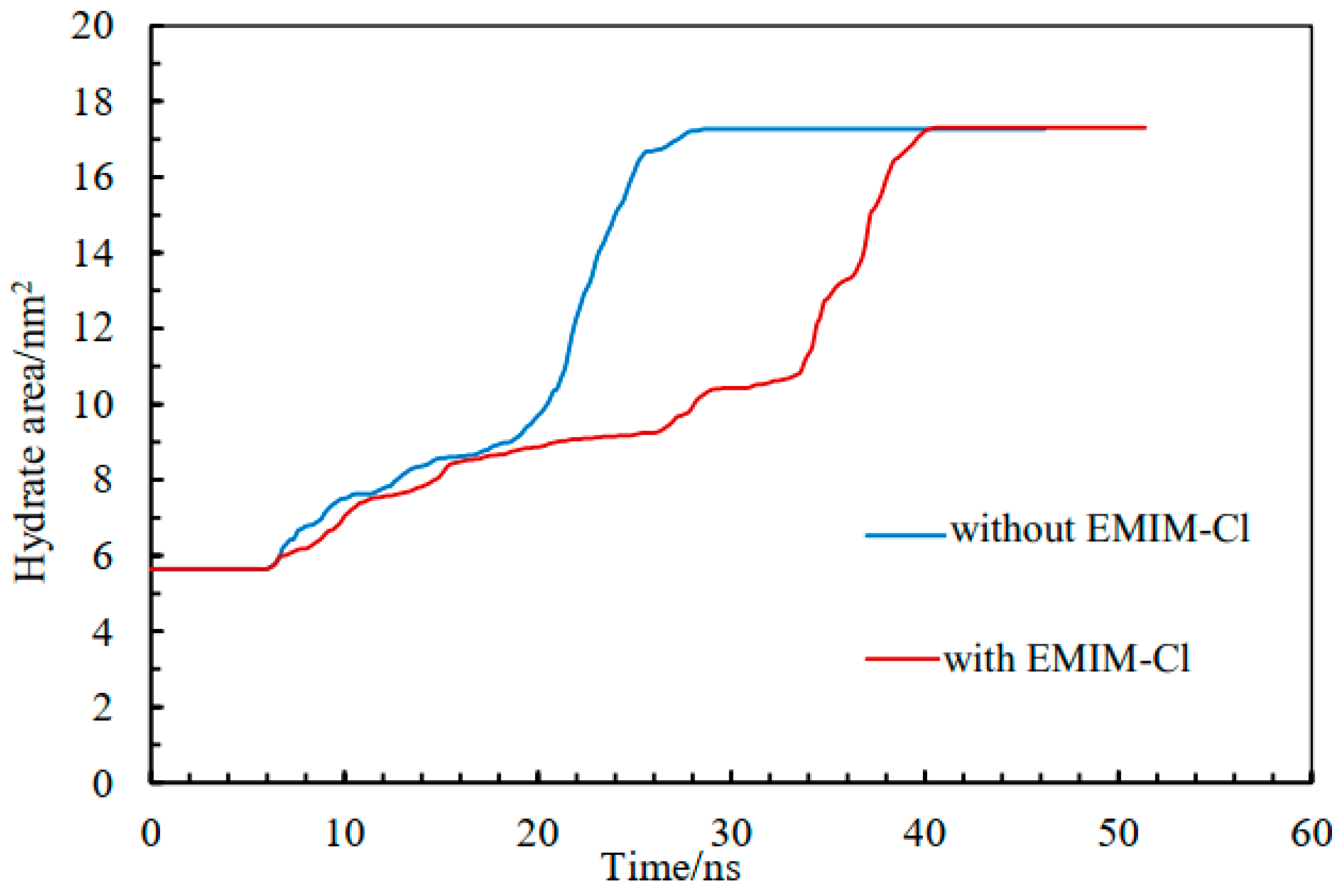
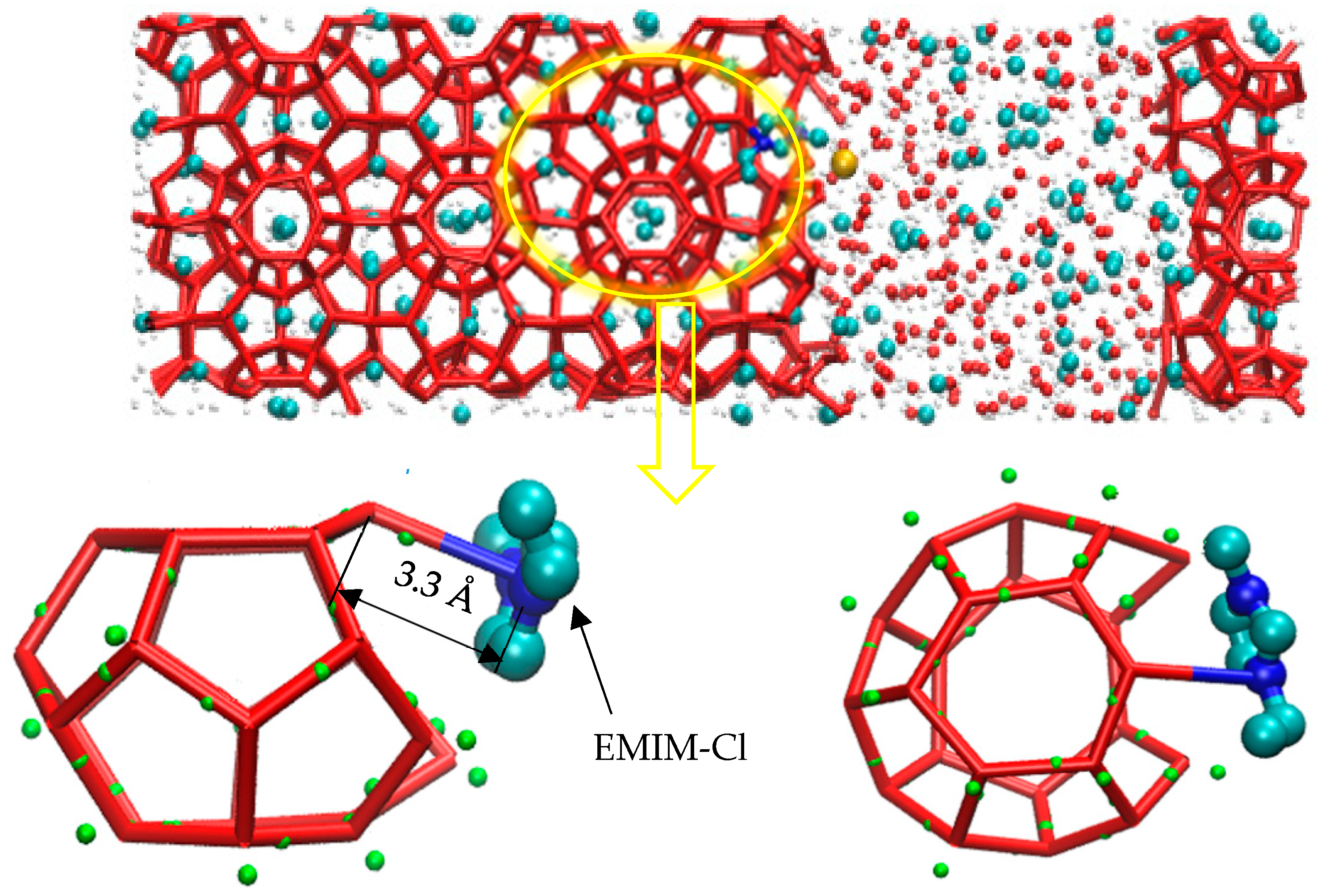


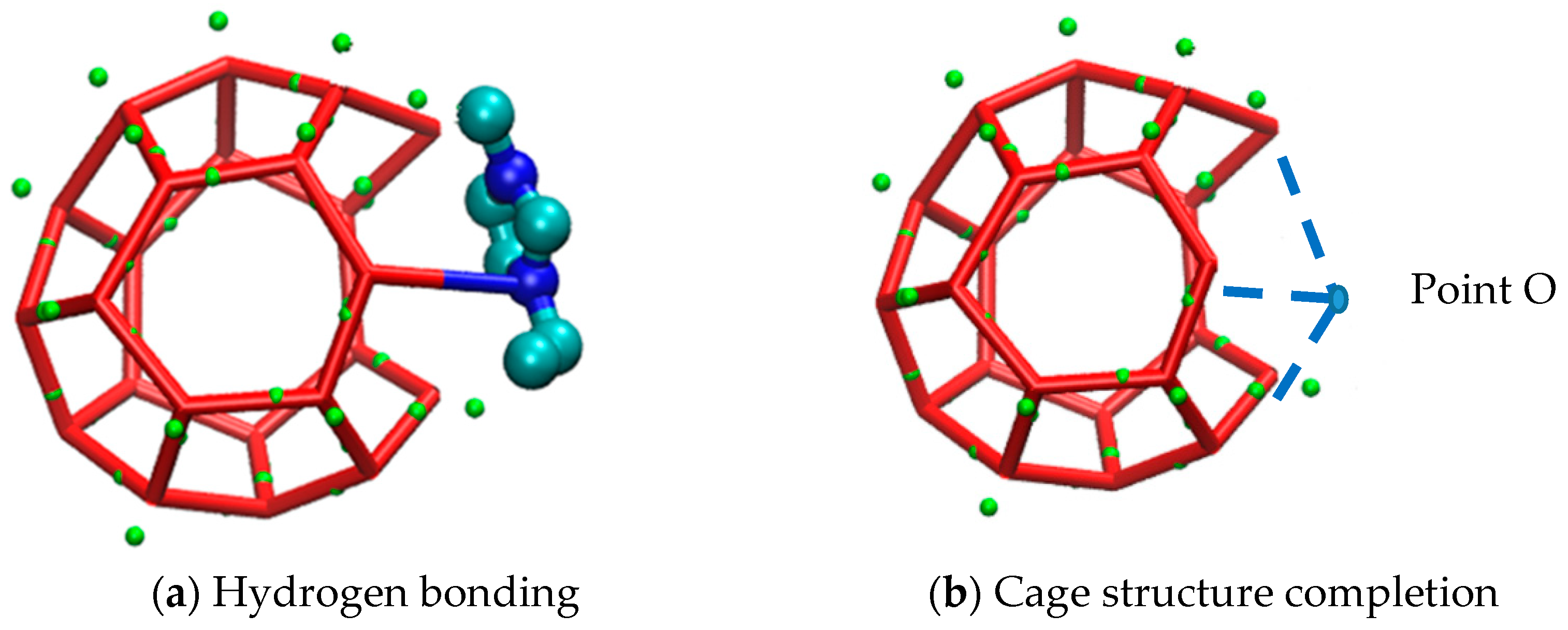
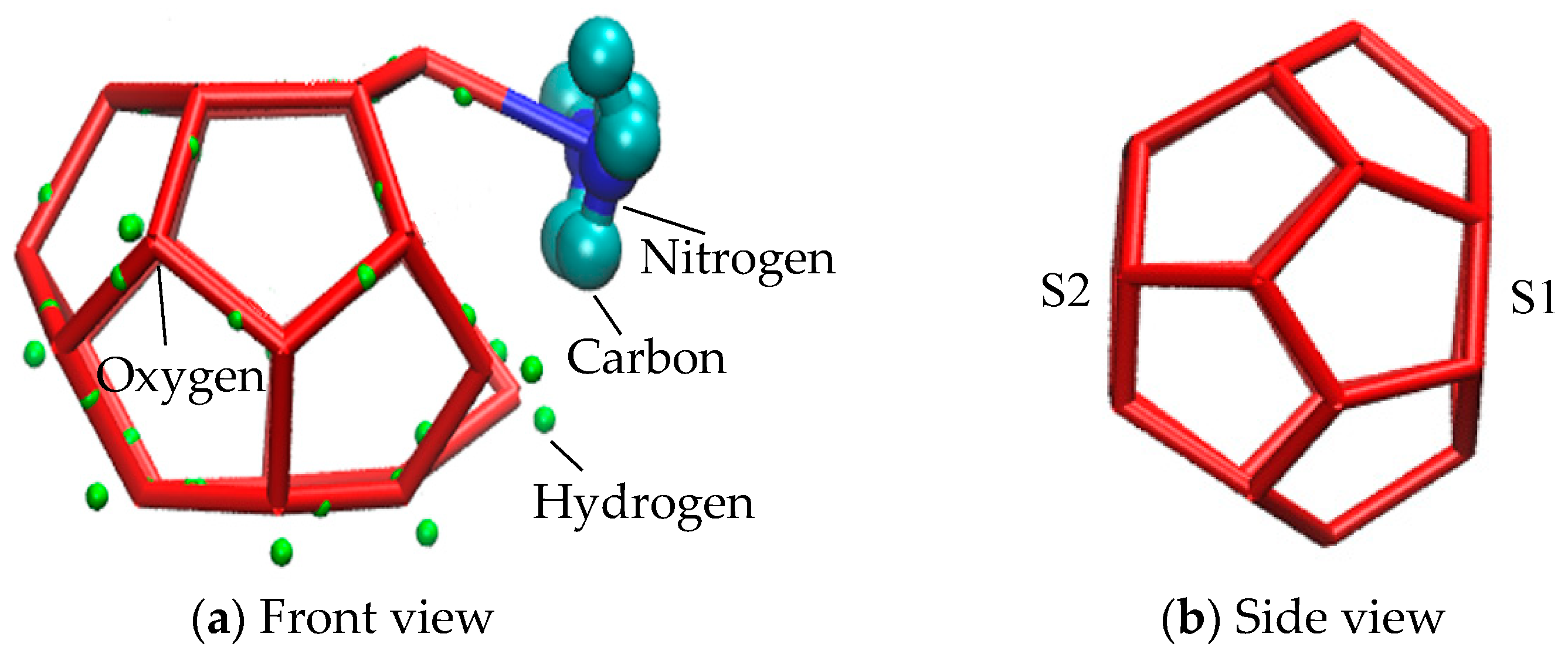
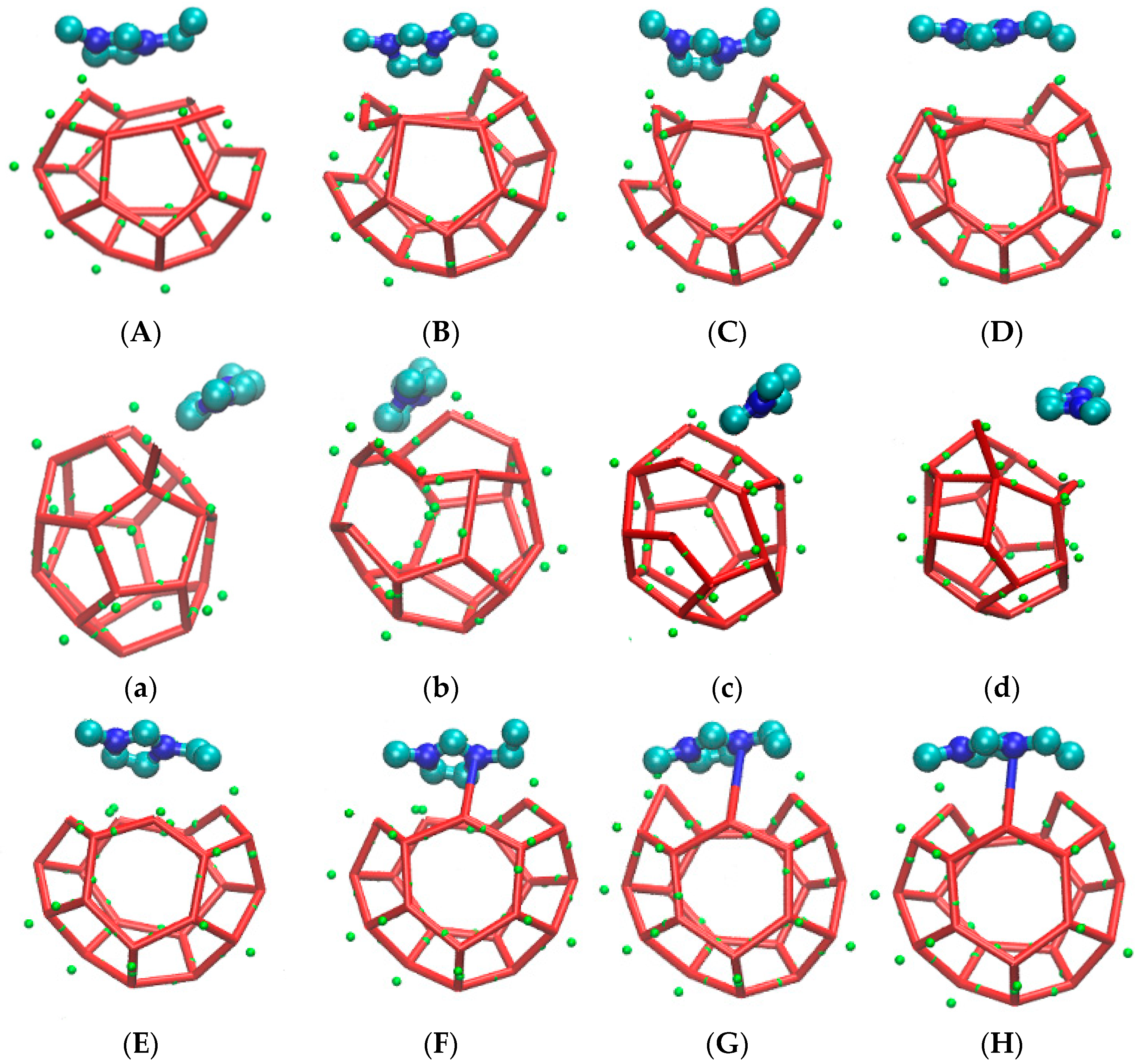

| Element | Molecular | ε (kcal/mol) | σ (Å) | Electric Charge |
|---|---|---|---|---|
| O | H2O | 0.16275 | 3.16435 | - |
| H | 0.000 | 0.000 | 0.5242 | |
| M | - | - | −1.0484 | |
| C | CH4 | 0.066 | 3.500 | −0.2400 |
| H | 0.030 | 2.500 | 0.0600 |
Publisher’s Note: MDPI stays neutral with regard to jurisdictional claims in published maps and institutional affiliations. |
© 2022 by the authors. Licensee MDPI, Basel, Switzerland. This article is an open access article distributed under the terms and conditions of the Creative Commons Attribution (CC BY) license (https://creativecommons.org/licenses/by/4.0/).
Share and Cite
Xin, G.; Xu, N.; Li, H.; Yin, F.; Qi, Y.; Li, S.; Su, X.; Chen, Y.; Sun, B. Inhibition Mechanism of EMIM-Cl to Methane Gas Hydrate by Molecular Dynamics Simulation. Energies 2022, 15, 7928. https://doi.org/10.3390/en15217928
Xin G, Xu N, Li H, Yin F, Qi Y, Li S, Su X, Chen Y, Sun B. Inhibition Mechanism of EMIM-Cl to Methane Gas Hydrate by Molecular Dynamics Simulation. Energies. 2022; 15(21):7928. https://doi.org/10.3390/en15217928
Chicago/Turabian StyleXin, Guizhen, Na Xu, Hongwei Li, Faling Yin, Yaqiang Qi, Shaoqiang Li, Xinyao Su, Ye Chen, and Baojiang Sun. 2022. "Inhibition Mechanism of EMIM-Cl to Methane Gas Hydrate by Molecular Dynamics Simulation" Energies 15, no. 21: 7928. https://doi.org/10.3390/en15217928
APA StyleXin, G., Xu, N., Li, H., Yin, F., Qi, Y., Li, S., Su, X., Chen, Y., & Sun, B. (2022). Inhibition Mechanism of EMIM-Cl to Methane Gas Hydrate by Molecular Dynamics Simulation. Energies, 15(21), 7928. https://doi.org/10.3390/en15217928






